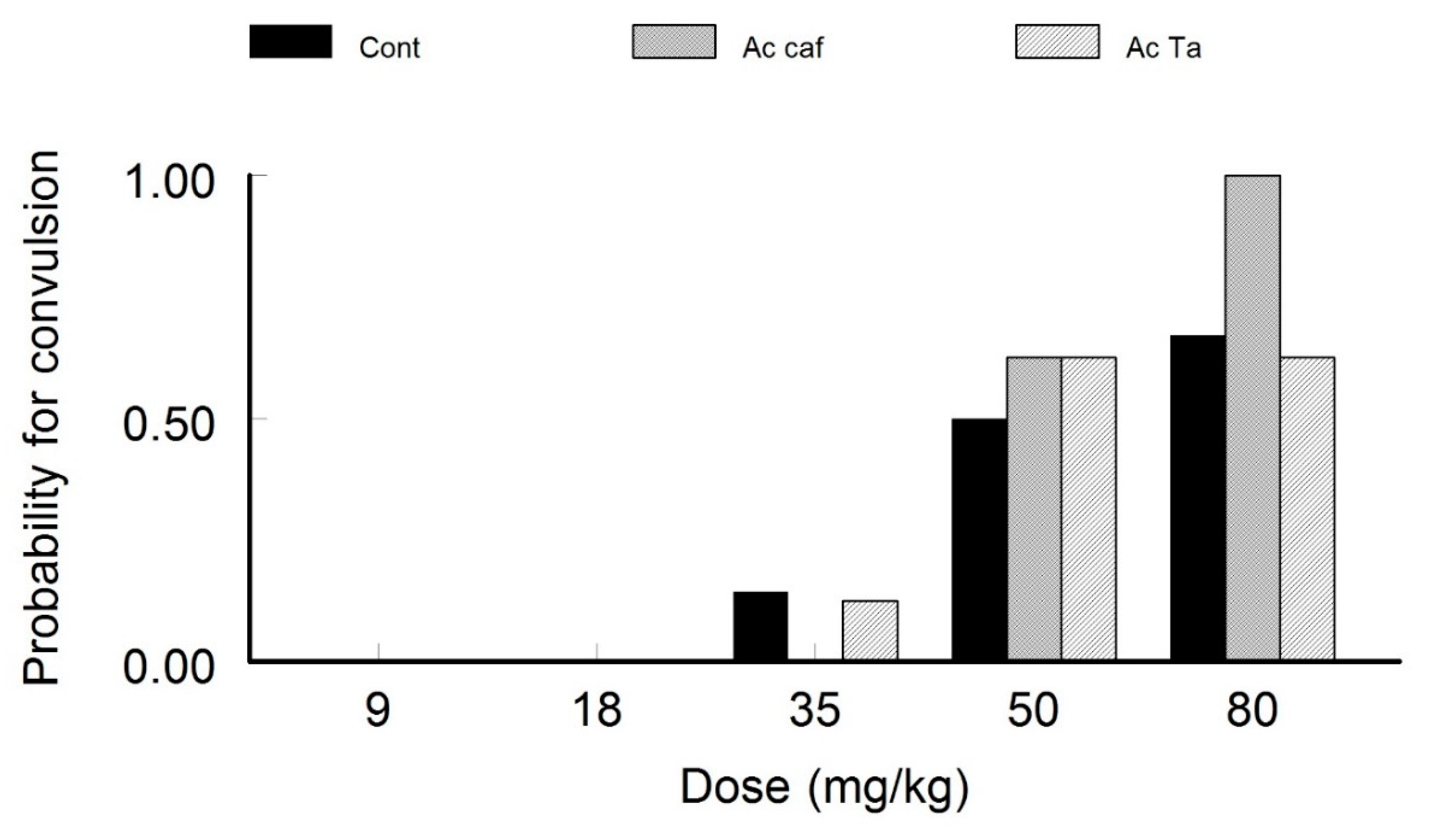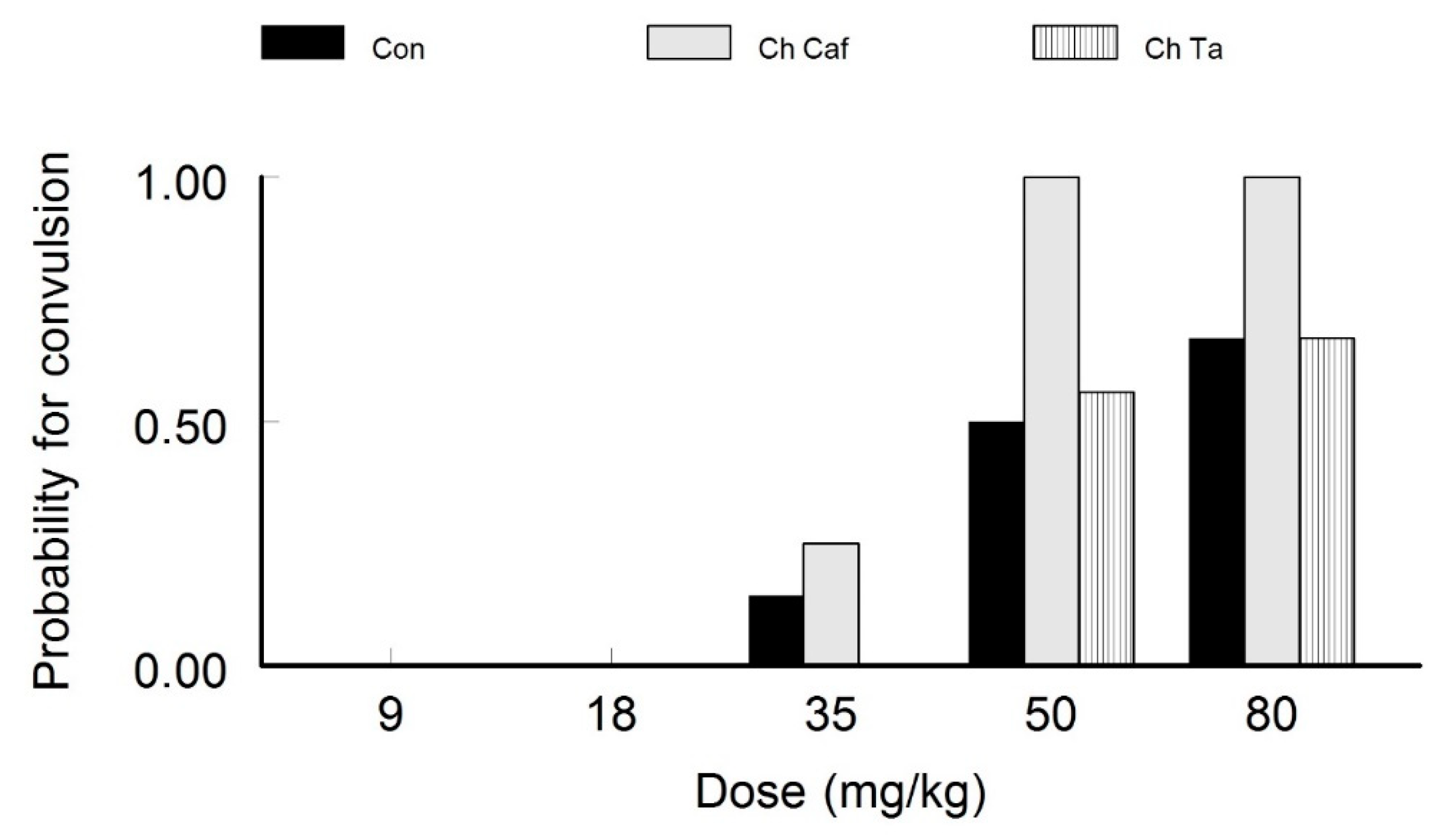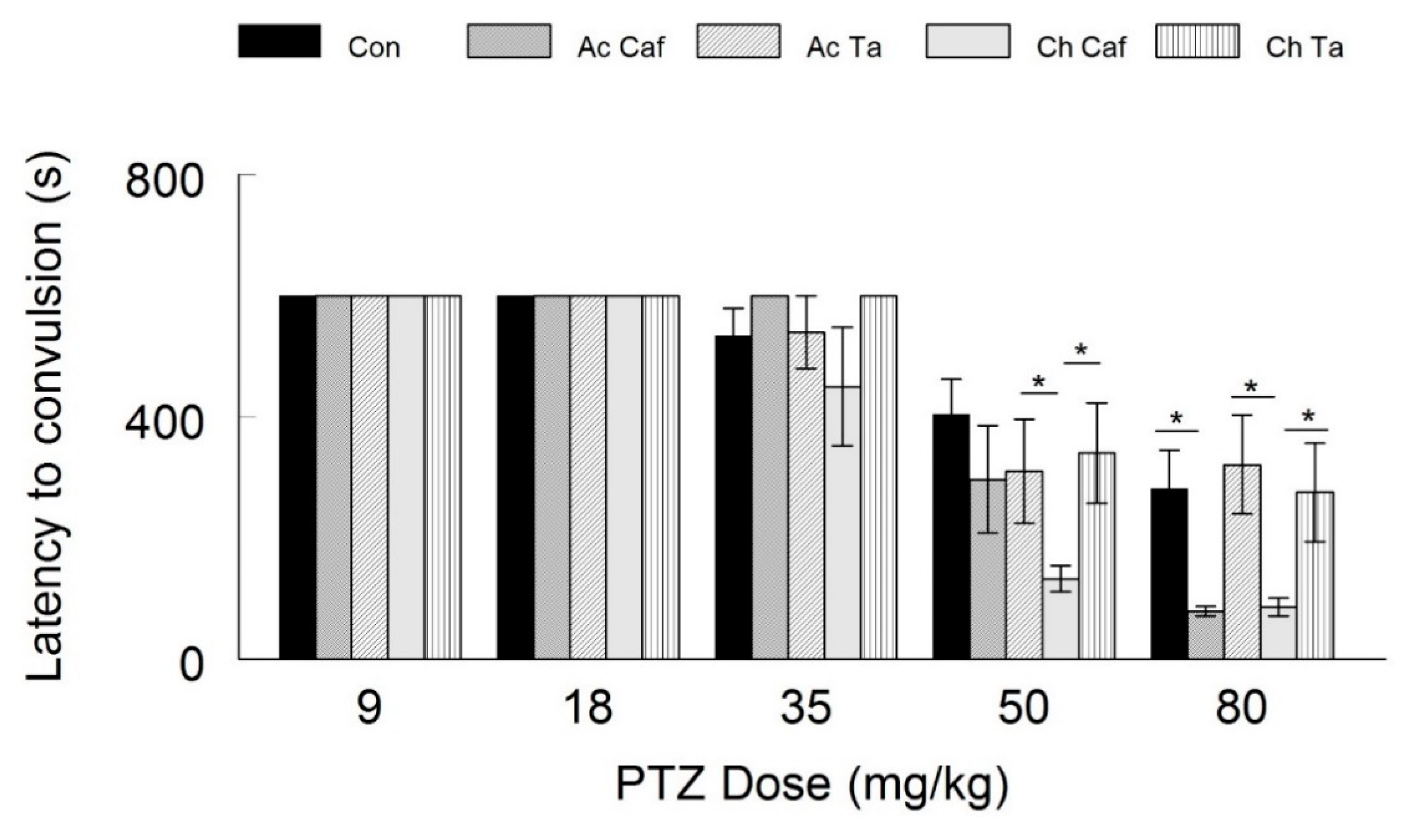The Effect of Low-Doses of Caffeine and Taurine on Convulsive Seizure Parameters in Rats
Abstract
1. Introduction
2. Methods
2.1. Animals
2.2. Caffeine Administration
2.3. Taurine Administration
2.4. Pentylenetetrazole Injections
2.5. Seizure Recognition
3. Data Analysis
4. Results
4.1. The Effect of Caffeine and Taurine Treatment on the Probability of PTZ-Induced Seizures
4.1.1. Acute Caffeine and Taurine Exposure
4.1.2. Chronic Caffeine and Taurine Exposure
4.2. The Effect of Caffeine and Taurine Treatment on the Latency of PTZ-Induced Seizures
5. Discussion
Author Contributions
Funding
Conflicts of Interest
Ethical Approval
References
- Fisher, R.S.; Boas, W.V.E.; Blume, W.; Elger, C.; Genton, P.; Lee, P.; Engel, J. Epileptic Seizures and Epilepsy: Definitions Proposed by the International League Against Epilepsy (ILAE) and the International Bureau for Epilepsy (IBE). Epilepsia 2005, 46, 470–472. [Google Scholar] [CrossRef]
- Trinka, E.; Höfler, J.; Zerbs, A. Causes of status epilepticus. Epilepsia 2012, 53, 127–138. [Google Scholar] [CrossRef]
- Kaufman, K.R.; Sachdeo, R.C. Caffeinated beverages and decreased seizure control. Seizure 2003, 12, 519–521. [Google Scholar] [CrossRef]
- Carrillo, J.A.; Benitez, J. Clinically Significant Pharmacokinetic Interactions Between Dietary Caffeine and Medications. Clin. Pharmacokinet. 2000, 39, 127–153. [Google Scholar] [CrossRef]
- Howell, L.L.; Coffin, V.L.; Spealman, R.D. Behavorial and physiological effects of xanthines in nonhuman primates. Psychopharmacology 1997, 129, 1–14. [Google Scholar] [CrossRef]
- Cunha, R. Adenosine as a neuromodulator and as a homeostatic regulator in the nervous system: different roles, different sources and different receptors. Neurochem. Int. 2001, 38, 107–125. [Google Scholar] [CrossRef]
- Jacobsen, J.G.; Smith, L.H. Biochemistry and physiology of taurine and taurine derivatives. Physiol. Rev. 1968, 48, 424–511. [Google Scholar] [CrossRef]
- Huxtable, R.J. Physiological actions of taurine. Physiol. Rev. 1992, 72, 101–163. [Google Scholar] [CrossRef]
- Oja, S.S.; Saransaari, P. Pharmacology of taurine. Proc. West. Pharmacol. Soc. 2007, 50. [Google Scholar]
- Wu, J.Y. Purification and characterization of cysteic acid and cysteine sulfinic acid decarboxylase and L-glutamate decarboxylase from bovine brain. Proc. Natl. Acad. Sci. USA 1982, 79, 4270–4274. [Google Scholar] [CrossRef]
- Schuller-Levis, G.B.; Park, E. Taurine: new implications for an old amino acid. FEMS Microbiol. Lett. 2003, 226, 195–202. [Google Scholar] [CrossRef]
- Kerai, M.D.J.; Waterfield, C.J.; Kenyon, S.H.; Asker, D.S.; Timbrell, J.A. Taurine: protective properties against ethanol-induced hepatic steatosis and lipid peroxidation during chronic ethanol consumption in rats. Amino Acids 1998, 15, 53–76. [Google Scholar] [CrossRef]
- Urquhart, N.; Perry, T.L.; Hansen, S.; Kennedy, J. Passage of taurine into adult mammalian brain. J. Neurochem. 1974, 22, 871–872. [Google Scholar] [CrossRef]
- El Idrissi, A.; Trenkner, E. Growth Factors and Taurine Protect against Excitotoxicity by Stabilizing Calcium Homeostasis and Energy Metabolism. J. Neurosci. 1999, 19, 9459–9468. [Google Scholar] [CrossRef]
- Häusser, M.; Yung, W.; Lacey, M. Taurine and glycine activate the same Cl− conductance in substantia nigra dopamine neurones. Brain Res. 1992, 571, 103–108. [Google Scholar] [CrossRef]
- Okamoto, K.; Kimura, H.; Sakai, Y. Effects of Taurine and GABA on Ca spikes and Na spikes in cerebellar Purkinje cells in vitro: Intrasomatic study. Brain Res. 1983, 260, 249–259. [Google Scholar] [CrossRef]
- Dunwiddie, T.V. Endogenously Released Adenosine Regulates Excitability in the In Vitro Hippocampus. Epilepsia 1980, 21, 541–548. [Google Scholar] [CrossRef]
- El Idrissi, A.; Messing, J.; Scalia, J.; Trenkner, E. Prevention of epileptic seizures by taurine. Single Mol. Single Cell Seq. 2003, 526, 515–525. [Google Scholar]
- Izumi, K.; Igisu, H.; Fukuda, T. Effects of edetate on seizure suppressing actions of taurine and GABA. Brain Res. 1975, 88, 576–579. [Google Scholar] [CrossRef]
- Ball, K.T.; Poplawsky, A. Low-dose oral caffeine induces a specific form of behavioral sensitization in rats. Pharmacol. Rep. 2011, 63, 1560–1563. [Google Scholar] [CrossRef]
- Fredholm, B.B.; Bättig, K.; Holmén, J.; Nehlig, A.; Zvartau, E.E. Actions of caffeine in the brain with special reference to factors that contribute to its widespread use. Pharmacol. Rev. 1999, 51, 83–133. [Google Scholar]
- Lu, C.-L.; Tang, S.; Meng, Z.-J.; He, Y.-Y.; Song, L.-Y.; Liu, Y.-P.; Ma, N.; Li, X.-Y.; Guo, S.-C. Taurine improves the spatial learning and memory ability impaired by sub-chronic manganese exposure. J. Biomed. Sci. 2014, 21, 51. [Google Scholar] [CrossRef]
- Ito, K.; Arko, M.; Kawaguchi, T.; Kuwahara, M.; Tsubone, H. The effect of subacute supplementation of taurine on spatial learning and memory. Exp. Anim. 2009, 58, 175–180. [Google Scholar] [CrossRef][Green Version]
- Canas, P.M.; Porciúncula, L.O.; Simões, A.P.; Augusto, E.; Silva, H.B.; Machado, N.J.; Gonçalves, N.; Alfaro, T.M.; Gonçalves, F.Q.; Araújo, I.M.; et al. Neuronal Adenosine A2A Receptors Are Critical Mediators of Neurodegeneration Triggered by Convulsions. Eneuro 2018, 5. [Google Scholar] [CrossRef]
- Goodman, R.; Synder, S. Autoradiographic localization of adenosine receptors in rat brain using [3H]cyclohexyladenosine. J. Neurosci. 1982, 2, 1230–1241. [Google Scholar] [CrossRef]
- Gundlfinger, A.; Bischofberger, J.; Johenning, F.W.; Torvinen, M.; Schmitz, D.; Breustedt, J. Adenosine modulates transmission at the hippocampal mossy fibre synapse via direct inhibition of presynaptic calcium channels. J. Physiol. 2007, 582, 263–277. [Google Scholar] [CrossRef]
- Dunwiddie, T.V. The Physiological Role of Adenosine In The Central Nervous System. Int. Rev. Neurobiol. 1985, 27, 63–139. [Google Scholar]
- Ferre, S.; Von Euler, G.; Johansson, B.; Fredholm, B.B.; Fuxe, K. Stimulation of high-affinity adenosine A2 receptors decreases the affinity of dopamine D2 receptors in rat striatal membranes. Proc. Natl. Acad. Sci. USA 1991, 88, 7238–7241. [Google Scholar] [CrossRef]
- Cunha, R.A. How does adenosine control neuronal dysfunction and neurodegeneration? J. Neurochem. 2016, 139, 1019–1055. [Google Scholar] [CrossRef]
- Shen, H.-Y.; Coelho, J.E.; Ohtsuka, N.; Canas, P.M.; Day, Y.-J.; Huang, Q.-Y.; Rebola, N.; Yu, L.; Boison, D.; Cunha, R.A.; et al. A Critical Role of the Adenosine A2A Receptor in Extrastriatal Neurons in Modulating Psychomotor Activity as Revealed by Opposite Phenotypes of Striatum and Forebrain A2A Receptor Knock-Outs. J. Neurosci. 2008, 28, 2970–2975. [Google Scholar] [CrossRef]
- Arai, A.; Kessler, M.; Lynch, G. The effects of adenosine on the development of long-term potentiation. Neurosci. Lett. 1990, 119, 41–44. [Google Scholar] [CrossRef]
- Greene, R.; Haas, H.; Hermann, A. Effects of caffeine on hippocampal pyramidal cells in vitro. Br. J. Pharmacol. 1985, 85, 163–169. [Google Scholar] [CrossRef]
- Chu, N.-S. Caffeine- and Aminophylline-Induced Seizures. Epilepsia 1981, 22, 85–94. [Google Scholar] [CrossRef] [PubMed]
- Czuczwar, S.J.; Janusz, W.; Wamil, A.; Kleinrok, Z. Inhibition of aminophylline-induced convulsions in mice by antiepileptic drugs and other agents. Eur. J. Pharmacol. 1987, 144, 309–315. [Google Scholar] [CrossRef]
- Chrościńska-Krawczyk, M.; Jargiełło-Baszak, M.; Wałek, M.; Tylus, B.; Czuczwar, S.J. Caffeine and the anticonvulsant potency of antiepileptic drugs: experimental and clinical data. Pharmacol. Rep. 2011, 63, 12–18. [Google Scholar] [CrossRef]
- Georgiev, V.; Johansson, B.; Fredholm, B.B. Long-term caffeine treatment leads to a decreased susceptibility to NMDA-induced clonic seizures in mice without changes in adenosine A1 receptor number. Brain Res. 1993, 612, 271–277. [Google Scholar] [CrossRef]
- Johansson, B.; Georgiev, V.; Kuosmanen, T.; Fredholm, B.B. Long-term treatment with some methylxanthines decreases the susceptibility to bicuculline- and pentylenetetrazol-induced seizures in mice. Relationship to c-fos expression and receptor binding. Eur. J. Neurosci. 1996, 8, 2447–2458. [Google Scholar] [CrossRef]
- Okamoto, K.; Kimura, H.; Sakai, Y. Taurine-induced increase of the Cl-conductance of cerebellar Purkinje cell dendrites in vitro. Brain Res. 1983, 259, 319–323. [Google Scholar] [CrossRef]
- Noor, N.A.; Mohammed, H.S.; Khadrawy, Y.A.; Ezz, H.S.A.; Radwan, N.M. Evaluation of the neuroprotective effect of taurine and green tea extract against oxidative stress induced by pilocarpine during status epilepticus. J. Basic Appl. Zool. 2015, 72, 8–15. [Google Scholar] [CrossRef]
- Piecoro, L.T.; Wermeling, D.P.; Schmitt, F.A.; Ashford, J.W. Seizures in patients receiving concomitant antimuscarinics and acetylcholinesterase inhibitor. Pharmacother. J. Hum. Pharmacol. Drug Ther. 1998, 18, 1129–1132. [Google Scholar]
- Yoshida, M.; Izumi, K.; Koja, T.; Fukuda, T.; Munekata, E.; Nakanishi, T. Inhibitory effect of taurine on wet-dog shakes produced by [d-Ala2,MET5] enkephalinamide with reference to effects on hippocampal epileptic discharges. Neuropharmacology 1986, 25, 1373–1378. [Google Scholar] [CrossRef]
- Eppler, B.; Patterson, T.A.; Zhou, W.; Millard, W.J.; Dawson, R.; Jr, R.D.; Eppler, B. Kainic acid (KA)-induced seizures in Sprague-Dawley rats and the effect of dietary taurine (TAU) supplementation or deficiency. Amino Acids 1999, 16, 133–147. [Google Scholar] [CrossRef] [PubMed]
- Chrościńska-Krawczyk, M.; Radzik, I.; Miziak, B.; Czuczwar, S.J. Safety considerations for patients with epilepsy taking antiepileptic drugs alongside caffeine or other methylxanthine derivatives. Expert Opin. Drug Metab. Toxicol. 2014, 10, 981–989. [Google Scholar] [CrossRef] [PubMed]
- Samsonsen, C.; Bråthen, G.; Reimers, A.; Helde, G.; Brodtkorb, E. Is dietary caffeine involved in seizure precipitation? Epilepsy Behav. 2013, 28, 147–150. [Google Scholar] [CrossRef]



© 2020 by the authors. Licensee MDPI, Basel, Switzerland. This article is an open access article distributed under the terms and conditions of the Creative Commons Attribution (CC BY) license (http://creativecommons.org/licenses/by/4.0/).
Share and Cite
Jailani, M.; Mubarak, M.; Sarkhouh, M.; Al Mahrezi, A.; Abdulnabi, H.; Naiser, M.; Alaradi, H.; Alabbad, A.; Hassan, M.; Kamal, A. The Effect of Low-Doses of Caffeine and Taurine on Convulsive Seizure Parameters in Rats. Behav. Sci. 2020, 10, 43. https://doi.org/10.3390/bs10020043
Jailani M, Mubarak M, Sarkhouh M, Al Mahrezi A, Abdulnabi H, Naiser M, Alaradi H, Alabbad A, Hassan M, Kamal A. The Effect of Low-Doses of Caffeine and Taurine on Convulsive Seizure Parameters in Rats. Behavioral Sciences. 2020; 10(2):43. https://doi.org/10.3390/bs10020043
Chicago/Turabian StyleJailani, Mohamed, Mohamed Mubarak, Mariam Sarkhouh, Ahmed Al Mahrezi, Habib Abdulnabi, Mohamed Naiser, Husain Alaradi, Abdulaziz Alabbad, Maram Hassan, and Amer Kamal. 2020. "The Effect of Low-Doses of Caffeine and Taurine on Convulsive Seizure Parameters in Rats" Behavioral Sciences 10, no. 2: 43. https://doi.org/10.3390/bs10020043
APA StyleJailani, M., Mubarak, M., Sarkhouh, M., Al Mahrezi, A., Abdulnabi, H., Naiser, M., Alaradi, H., Alabbad, A., Hassan, M., & Kamal, A. (2020). The Effect of Low-Doses of Caffeine and Taurine on Convulsive Seizure Parameters in Rats. Behavioral Sciences, 10(2), 43. https://doi.org/10.3390/bs10020043




